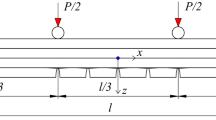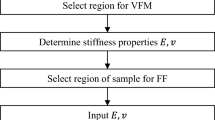Abstract
In this paper, an optimized and reliable approach for the evaluation of the mechanical properties of brittle materials is proposed and applied to the characterization of geopolymer mortars. In particular, the Young’s modulus, the Poisson’s ratio and the tensile strength are obtained by means of a Brazilian disk test combined with the digital image correlation (DIC) technique. The mechanical elastic properties are evaluated by a special routine, based on an over-deterministic method and the least square regression, that allows to fit the displacement fields experienced by the samples during the experiment. Error sources, like center of the disk location and rigid-body motion components, were analyzed and estimated automatically with the proposed procedure in order to perform an accurate evaluation of the elastic constants. The strain field measured by DIC and the computed elastic properties were then used to perform a local stresses analysis. This latter was exploited to investigate the failure mechanisms and to evaluate the tensile strength of the investigated material and the obtained data were compared with those predicted by the ASTM and ISMR standards. Three different loading platens (flat, rod and curved) were adopted for the Brazilian test in order to evaluate their effect on the elastic properties calculation, on the failure mechanisms and tensile strength evaluation. Results reveal that the curve platens are the most suitable for the tensile strength calculation, whereas the elastic properties did not show any influence from the loading configuration. Furthermore, the proposed procedure, of easy implementation, allows to accurately calculate Young’s modulus, Poisson’s ratio and the tensile strength of brittle materials in a single experiment.






Similar content being viewed by others
References
Carneiro FLLB (1943) A new method to determine the tensile strength of concrete. Paper presented at the proceedings of the 5th meeting of the Brazilian association for technical rules, 3d. section
Akazawa T (1943) New test method for evaluating internal stress due to compression of concrete: the splitting tension test. J Jpn Soc Civ Eng 29:777–787
ASTM C496 (1984) Standard test method for splitting tensile strength of cylindrical concrete specimens, vol 0.042. Annual Book of ASTM, Standards. ASTM, Philadelphia, pp 336–341
Fairhurst C (1964) On the validity of the ‘Brazilian’ test for brittle materials. Int J Rock Mech Min Sci Geomech Abstr 1(4):535–546
Hooper JA (1971) The failure of glass cylinders in diametral compression. J Mech Phys Solids 19(4):179–200
Hudson JA, Brown ET, Rummel F (1972) The controlled failure of rock discs and rings loaded in diametral compression. Int J Rock Mech Min Sci Geomech Abstr 9(2):241–248
Swab JJ, Yu J, Gamble R, Kilczewski S (2011) Analysis of the diametral compression method for determining the tensile strength of transparent magnesium aluminate spinel. Int J Fract 172:187–192
Li Diyuan, Wong Louis Ngai Yuen (2016) The Brazilian disc test for rock mechanics application: review and new insight. Rock Mech Rock Eng 46:269–287
Wang QZ, Jia XM, Kou SQ, Zhang ZX, Lindqvist PA (2004) The flattened Brazilian disc specimen used for testing elastic modulus, tensile strength and fracture toughness of brittle rocks: analytical and numerical results. Int J Rock Mech Min Sci 41:245–253
ISRM (1978) Suggested methods for determining tensile strength of rock materials. Int J Rock Mech Min Sci 15(3):99–103
Cardenas-Garcia JF (2001) The Moiré circular disc: two inverse problems. Mech Res Commun 28(4):381–387
Wang Z, Cardenas-Garcia JF, Han B (2004) Inverse method to determine elastic constants using a circular disk and Moiré interferometry. Exp Mech 45(1):27–34
Khlifi I, Dupré JC, Doumalin P, Belrhiti Y, Pop O, Huger M (2017) Improvement of digital image correlation for the analysis of the fracture behaviour of Refractories. In: 23ème Congrès Français de Mécanique, Lille, 28 Aug–Sept 2017
Lai S, Shi L, Fok A, Li H, Sun L, Zhang Z (2017) A new method to measure crack extension in nuclear graphite based on digital image correlation. Sci Technol Nucl Install 2017:1–10
Stirling RA, Simpson DJ, Davie CT (2013) The application of digital image correlation to Brazilian testing of sandstone. Int J Rock Mech Min Sci 60:1–11
Liu C (2010) Elastic constants determination and deformation observation using Brazilian disk geometry. Exp Mech 50:1025–1039
Hild F, Roux S (2006) Digital image correlation: from displacement measurement to identification of elastic properties—a review. Strain 42:69–80
Timoshenko S, Goodier J (1970) Theory of elasticity, 3rd edn. McGraw-Hill Book Company, Inc, New York
Markides ChF, Pazis DN, Kourkoulis SK (2010) Closed full-field solutions for stresses and displacements in the Brazilian disk under distributed radial load. Int J Rock Mech Min Sci 47:227–237
Kourkoulis SK, Markides ChF, Chatzistergos PE (2012) The Brazilian disc under parabolically varying load: theoretical and experimental study of the displacement field. Int J Solids Struct 49:959–972
Muskhelishvili HN (1958) Some basic problems in mathematic elastic mechanics (Translated by Zhao Huiyuan). Science Press, Beijing
Davidovits J (1982) Mineral polymers and methods for making them, US Patent 4; 349,386
Lamuta C, Candamano S, Crea F, Pagnotta L (2016) Direct piezoelectric effect in geopolymeric mortars. Mater Des 107:57–64
Duxson P, Fernández Jiménez A, Provis JL, Lukey GC, Palomo A, van Deventer JSJ (2007) Geopolymer technology: the current state of the art. J Mater Sci 42:2917–2933
C. Solutions (2009) VIC-2D Testing Guide
ASTM C 1161-02c (2003) Standard test method for flexural strength of advanced ceramics at ambient temperature
Ajovalasit A (2006) Analisi Sperimentale delle tensioni con gli estensimetri elettrici a resistenza. Aracne Editrice S.r.l, Roma
Acknowledgements
The authors wish to thank “MaTeRiA Laboratory” (University of Calabria), funded with “Pon Ricerca e Competitività 2007/2013”, for providing equipment to perform the experiments.
Author information
Authors and Affiliations
Corresponding author
Ethics declarations
Conflict of interest
The authors declare that they have no conflict of interest.
Ethical approval
This chapter does not contain any studies with human participants or animals performed by any of the authors.
Electronic supplementary material
Below is the link to the electronic supplementary material.
Rights and permissions
About this article
Cite this article
Sgambitterra, E., Lamuta, C., Candamano, S. et al. Brazilian disk test and digital image correlation: a methodology for the mechanical characterization of brittle materials. Mater Struct 51, 19 (2018). https://doi.org/10.1617/s11527-018-1145-8
Received:
Accepted:
Published:
DOI: https://doi.org/10.1617/s11527-018-1145-8




